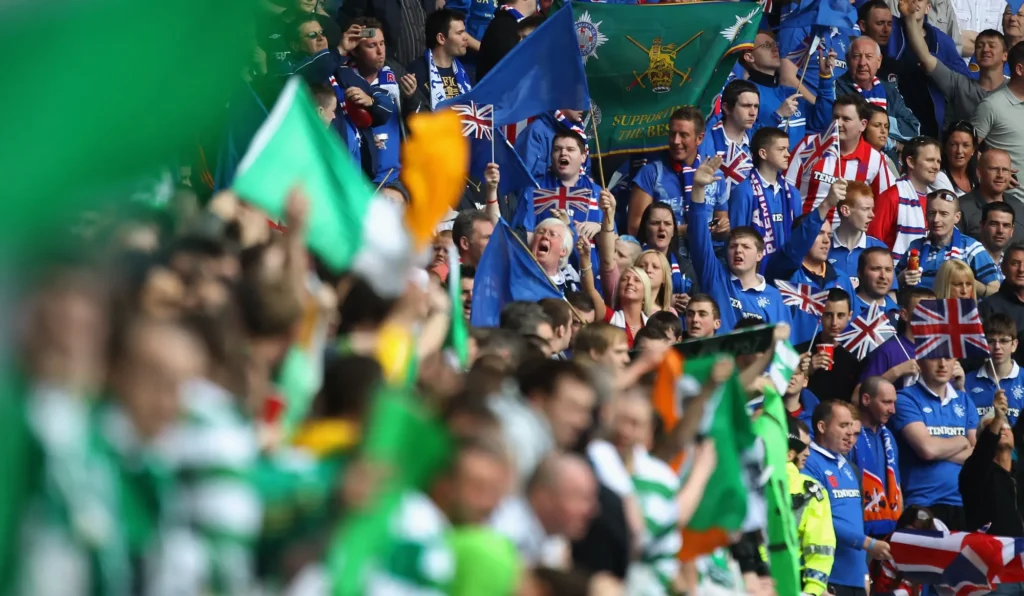In the world of football – few rivalries match the intensity and historical depth of the Old Firm derby in Scotland. This fierce competition between Glasgow’s Celtic and Rangers is not just a battle for supremacy on the pitch but also a clash of cultures, religions and political ideologies. For those passionate about football rivalries – understanding the Old Firm derby is essential.
Historical Roots and Sectarian Divides
The Old Firm derby’s origins stretch back over a century but its roots are deeply embedded in the history of Ireland and Scotland. The rivalry between Celtic and Rangers transcends football, intertwining with the religious and political tensions between Protestants and Catholics. Rangers’ supporters, often Protestant and loyal to the British Crown, contrast sharply with Celtic’s predominantly Catholic fanbase, who are proud of their Irish heritage and lean towards Irish nationalism.
This sectarian divide manifests itself starkly in Glasgow. While Rangers fans wave the Union Jack and align themselves with Protestant loyalists, Celtic supporters are known for their green and white colors, proudly displaying Irish flags and symbols of Catholicism.
Football and Beyond
Unlike many football rivalries – the Old Firm derby is steeped in religious and political significance, adding layers of complexity to each match. This aspect of the rivalry is often referred to as “sectarianism,” where the conflict extends beyond the football field and into the social and cultural fabric of the city.
Traditionally, Rangers had an unwritten policy of not signing Catholic players. This was dramatically challenged in 1989 when Graeme Souness, the then-manager of Rangers, signed Maurice Johnston, a Catholic and former Celtic player. This move shocked the football world and even led to death threats against Souness from Rangers’ supporters. On the other hand, Celtic has been more inclusive, fielding players regardless of their religious background.

Iconic Moments and Controversies
The Old Firm derby has produced countless memorable and controversial moments. One infamous incident involved Paul Gascoigne, a Rangers player, who mimicked a Protestant flute-playing march, provoking the Celtic fans. This act led to severe repercussions, including death threats from the Irish Republican Army (IRA).
Another notable figure is Artur Boruc, Celtic’s Polish goalkeeper, known for his overt Catholic gestures such as crossing himself in front of Rangers’ fans, which further fueled the rivalry. These acts of defiance and the passionate responses they provoke underscore the deep-seated animosity between the two sets of supporters.
Economic and Cultural Impact
The Old Firm rivalry is not just a local phenomenon; it has significant economic and cultural implications. The matches between Celtic and Rangers attract massive audiences, both in stadiums and on television – contributing substantially to the Scottish economy. When Rangers were demoted to the third division due to financial issues in 2012, it was not a cause for celebration for Celtic. The absence of their arch-rivals impacted the Scottish league’s appeal and financial health.
The rivalry also extends internationally. Celtic enjoys strong support from the Irish diaspora – particularly in the United States. Cities like Boston, with large Irish communities, are hotspots for Celtic fandom. On the other hand, Rangers’ fanbase, though smaller globally, remains deeply loyal and widespread.
Fan Loyalty and Stadium Atmosphere
Both clubs boast some of the most passionate and loyal supporters in the world. Despite their relegation, Rangers continued to draw nearly full houses at Ibrox Stadium, with attendance figures close to 50,000. Similarly, Celtic Park regularly sees crowds of around 57,000, making Celtic one of the most well-supported clubs globally.
The atmosphere at an Old Firm match is unparalleled. The sea of colors, the chants and the sheer intensity of the fans create a spectacle that is both thrilling and daunting. It’s not just a football match; it’s a cultural event that captivates the city and its people.
Conclusion
The Old Firm derby between Celtic and Rangers is more than just a football rivalry. It’s a clash of identities, a battle of beliefs and a reflection of Glasgow’s complex social fabric. Whether you’re a football fan or a cultural enthusiast, understanding the Old Firm is key to appreciating the depth and passion that define one of the most intense rivalries in the sport.


